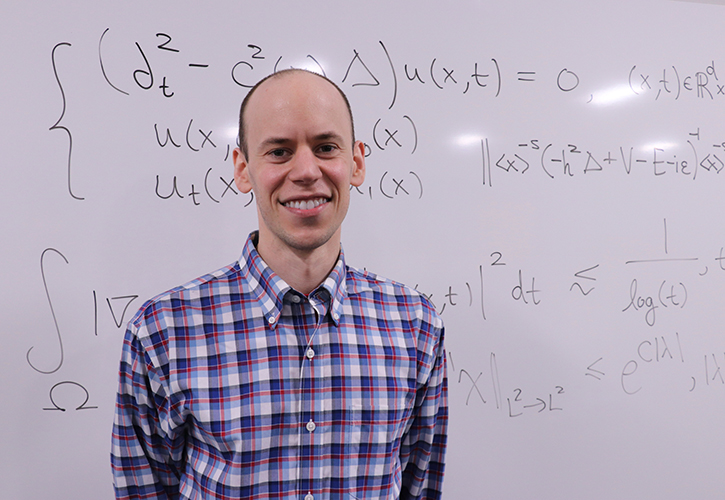College of Arts and Sciences Newsroom

UD mathematician awarded Fulbright for research in Australia
By Dave Larsen
University of Dayton mathematician Jacob Shapiro was selected as a Fulbright U.S. Scholar for the 2022-23 academic year to study the behavior of waves in a rough medium — such as a seismic wave traveling in the Earth’s subsurface — at the University of Melbourne in Australia.
Shapiro, an assistant professor of mathematics whose research focuses on partial differential equations and scattering theory, will try to prove some “admittedly abstract theorems” about how a wave’s localized energy decays when it meets obstructions. He likens his approach to the popular sitcom The Big Bang Theory.
“There are times in an episode of The Big Bang Theory where they have a whiteboard in the background and it just has a bunch of crazy formulas scrawled all over it,” he said. “Well, that’s actually a pretty accurate depiction of the day-to-day efforts of mathematicians and theory people.”
Sponsored by the U.S. Department of State, Fulbright Scholar Awards are prestigious and competitive fellowships for scholars to teach and conduct research abroad.
Shapiro, who joined the University of Dayton faculty in August 2020, was a postdoctoral fellow at Australian National University in Canberra.
“In some sense I view this award as a continuation of that,” he said. “I really enjoyed my time there and one of my long-term professional goals is to maintain those links with the Australian mathematics community. I hope there are other opportunities down the road, not just for research but also student experiences and some sort of cross-cultural exchange with the University of Dayton.”
He plans to study in Australia from January to August 2023. He will collaborate with his postdoctoral mentor, Jesse Gell-Redman, and Volker Schlue, who are senior lecturers in pure mathematics at the University of Melbourne’s School of Mathematics and Statistics.
Mathematicians and physicists have long used partial differential equations to accurately predict the movement of sound, light and gravitational waves in the natural world. However, fundamental questions remain about wave behavior, especially for waves traveling in a rough medium.
“It’s important to understand how waves travel through space because that’s one significant way that information is transported from A to B,” Shapiro said. “You could think about seismic waves telling you how strong or how far away an earthquake was, or electromagnetic waves helping you identify some target at a distance that you can’t directly perceive. There are also analogs of this in theoretical physics — certain waves are produced by black holes that tell you important information about the character of these very cosmic objects.”
His theorems could inform predictions about wave behavior when the medium is cluttered with obstructions and discontinuities, rather than being smooth.
“The main thrust of my work is to try to develop models that are as precise as the ones that we already have for the simpler situations,” he said.
While there may not be immediate applications for his research, it could lead to future benefits to society. For example, the subfield of differential equations that Shapiro studies to model wave behavior underpins medical imaging technology such as PET, MRI and CT scans. It also has applications for understanding seismic activity and looking for oil deposits and minerals under the Earth’s surface.
“One of the great benefits of the Fulbright is that it is this focused research period in which I can gain some new perspective on this area of research, and propose new and promising directions about different aspects of wave propagation,” he said. “That’s a very crucial and also fun and enjoyable part of the math research process.”
Shapiro, who has published in top journals such as Mathematical Research Letters and International Mathematics Research Notices, expects the project to result in four publications. He and Gell-Redman also plan to share their results at national and international conferences. During his award period, Shapiro will give talks about the project at several Australian universities.
He also hopes the award will be the initial phase of a long-term partnership with Gell-Redman and other Australian partial differential equation experts, which could result in UD master’s students working with Australian mathematicians.
“Dr. Shapiro already spent two years as a postdoc in Australia, and he will have the opportunity to collaborate with one of his former mentors,” said Wiebke Diestelkamp, professor and chair of the Department of Mathematics. “Their research on wave propagation in rough media will be important to mathematical physics, but may also in the long run lead to advances in technology that facilitate the development of new geological and medical imaging techniques. I expect that Dr. Shapiro’s work with faculty and students at the University of Melbourne will translate into collaborations with his colleagues and graduate students here at UD.”
For more information, visit the Department of Mathematics website.
